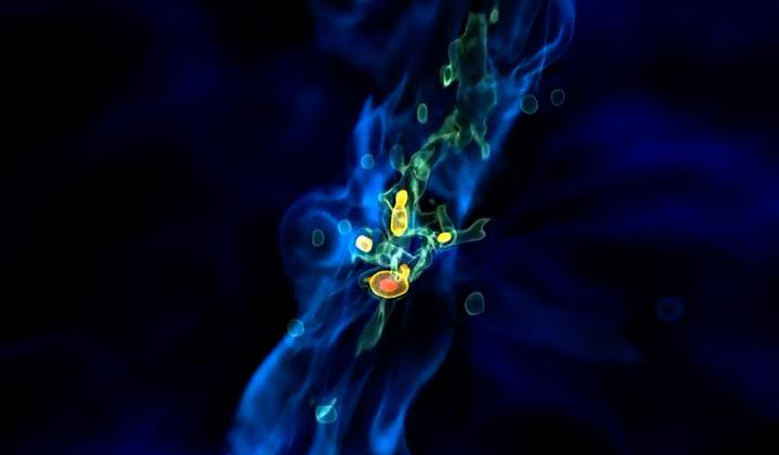Using a new computer simulation scientists have found evidence that ‘direct collapse’ black holes, which were revealed for the first time last year, can evolve to become the central engine of massive, luminous quasars that were formed less than a billion years after the big bang.
Last year, scientists discovered evidence for an unusual kind of black hole born extremely early in the Universe. Termed ‘direct collapse’ black holes (DCBHs), these massive objects start from a "seed" black hole, created when an extremely massive star collapses. It was then postulated that perhaps DCBHs helped form another type of perplexing object – supermassive black holes (SMBHs).
Supermassive black holes are some of the most important objects in the Universe. Not only do they drive the dynamics of a galaxy by spewing a vast amount of hot radiation into the Universe, they also act as gravitational anchors. SMBHs are also thought to power highly luminous quasars, but how such gigantic objects formed so early on has been a long-standing puzzle in astronomy.
Quasars are among the most luminous and energetic objects known in the Universe, emitting up to a thousand times the energy output of the Milky Way, and it is thought that quasars are driven by the infall of material into the supermassive black hole.
However, to make all of this work, a supply of matter is needed to accrete onto the supermassive black hole. Although the first generation of stars created after the Big Bang can collapse to form black holes, they didn’t work as early quasar seeds as stars produce feedback that blows away the surrounding gas cloud, thus cutting off the ‘food’ source. So it was a catch-22 situation; quasars need supermassive black holes, which need DCBHs, which need massive stars to form, but massive stars destroy the chance of quasars evolving by starving it of material.
Now, a new computer simulation created by scientists at the Theoretical Design Division at Los Alamos National Laboratory, has helped link all of these processes together showing that supermassive black holes are the central engines of luminous quasars found in the early epochs of the Universe.
The simulations show that supermassive black holes can form from DCBHs if their growth is fed by cold, dense accretion streams – a process that is already thought to fuel the rapid growth of some galaxies at later times.
"It turns out that while supermassive black holes have a growth speed limit, certain types of massive stars do not," said Joseph Smidt from Los Alamos and lead author of a recent research paper submitted to The Astrophysical Journal. In certain configurations of their simulations, Smidt and colleagues found that stars could grow as large as the size of many thousands of suns before collapsing into DCBHs, thus leading the way for supermassive black hole formation.
Not only that, but results from the model were also a fit with many other phenomena associated with black holes that are routinely observed by astrophysicists, such as star formation rates, galaxy density profiles, and thermal and ionisation rates in gasses.
"This was largely unexpected," said Smidt. "I thought this idea of growing a massive star in a special configuration and forming a black hole with the right kind of masses was something we could approximate, but to see the black hole inducing star formation and driving the dynamics in ways that we've observed in nature was really icing on the cake."
"We've gotten to a point at Los Alamos," added Smidt, "with the computer codes we're using, the physics understanding, and the supercomputing facilities, that we can do detailed calculations that replicate some of the forces driving the evolution of the Universe."











